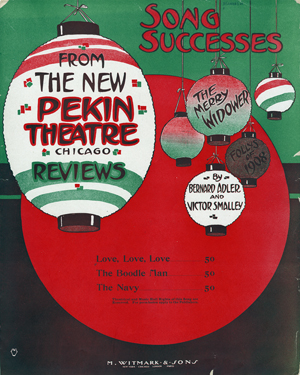| Sun | Mon | Tue | Wed | Thu | Fri | Sat |
|---|---|---|---|---|---|---|
| 1 | 2 | 3 | 4 | 5 | ||
| 6 | 7 | 8 | 9 | 10 | 11 | 12 |
| 13 | 14 | 15 | 16 | 17 | 18 | 19 |
| 20 | 21 | 22 | 23 | 24 | 25 | 26 |
| 27 | 28 | 29 | 30 | 31 |
CATEGORIES
RECENT ENTRIES
BLOG ROLL
All that jazz
 In June 2000, when lifelong jazz aficionado John Steiner bequeathed his collection of recordings and other materials to the University, jazz archivist Deborah Gillaspie, AM’88, walked into Steiner’s basement to find an extraordinary collection, remarkable for its unmatched contents—and its nonexistent organization.
In June 2000, when lifelong jazz aficionado John Steiner bequeathed his collection of recordings and other materials to the University, jazz archivist Deborah Gillaspie, AM’88, walked into Steiner’s basement to find an extraordinary collection, remarkable for its unmatched contents—and its nonexistent organization.
At a May 1 workshop led with fellow Special Collection Research Center (SCRC) librarian David Pavelich, Gillaspie explored the University’s jazz archives and described the mayhem. “It was an archaeological dig," she said.
The dig was fruitful. Steiner’s basement yielded nearly 35,000 recordings and 200 linear feet (a standard measurement in library terms) of photos, arrangements, posters, periodicals, and all types of ephemera.
When the materials (all four moving vans full) arrived at the Reg, the Steiner Collection found a home on the third floor, where the rest of the University’s jazz archive sat in cardboard boxes, unprocessed. When researchers wanted to access materials, they spoke directly to Gillaspie, the only person who knew what and where everything was.
The University’s jazz collection had been growing since 1976, but the quantity and variety of materials were such that the University didn’t have the resources for proper organization.
“There was no money to process it, no money for staff,” Gillaspie told the audience of 20. “So here it sat.”
That changed in 2006. The University received a grant from the Mellon Foundation to process the collection, and since then, the SCRC has organized it to make materials as accessible as possible. Among the tools the SCRC offers are online databases that allow jazz researchers and enthusiasts to know the collection's contents before coming to the library.
Because of Chicago’s tight-knit community of jazz experts, the library provides resources that extend far beyond the University’s own collection. A jazz drummer herself, Gillaspie knew several of the archive’s benefactors, and she discussed the music with a familiarity that several members of the audience seemed to share. She talked about the contents of collections like that of Chicago saxophonist Franz Jackson, adding a quick “for those of you who knew Franz” before moving on.
With the library continuing to process its latest acquisitions, Pavelich said the SCRC is receiving more requests than in the past. The researchers, in turn, are happy about the reorganization of collections like Steiner’s; now they can easily dig into the material without having to dig for it.
Jake Grubman, '11
May 11, 2010
